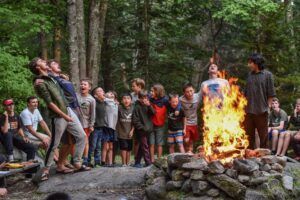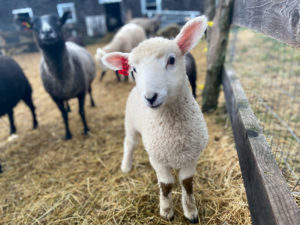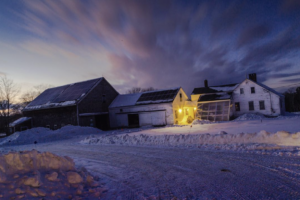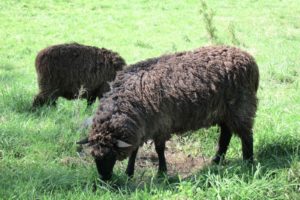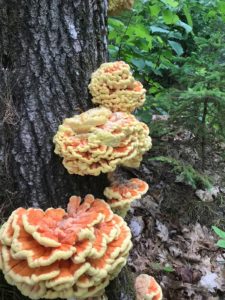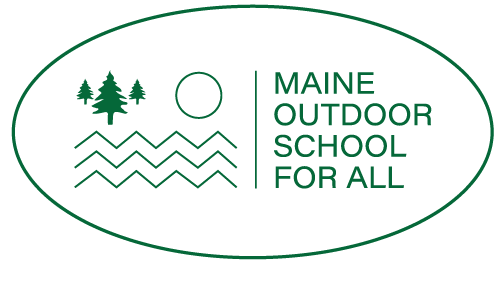Moments after 9:30 am on Saturday morning, the 45 students in Semester 59 gathered in a circle on the quad before heading off in small groups in seven distinct directions. They carried loppers and hand pruners, shovels and maps. All donned work gloves on their hands – their most critical tool in the next two hours – to both protect from cold and prickly plants. Their task? To identify invasive plants on Chewonki Neck and initiate control measures, from pulling to chopping to digging up massive root balls.

What do the following areas of Chewonki Neck have in common: the periphery of the main campus, the edges of Chewonki Neck Road, and the Old Foundation (site of one of the earliest settlements by white people on the peninsula)?
A. They are part of the rich cultural and historical landscape of Chewonki Neck.
B. They are home to many species of invasive plants.
C. They are or have been managed and impacted by humans.
D. All of the above.
Kudos to all who guessed “D!” As manager of Chewonki’s farm and woodlot, I’ve been vaguely aware of the need for invasive plant control on Chewonki Neck for many years. We weed our gardens almost daily throughout the growing season, but we have not been managing for invasive species in our wooded areas and around campus. And, though I knew of the problem, I didn’t know how or where to tackle it.
Imagine, then, the pleasant surprise associated with a summer phone call from Molly Docherty, who works with the Maine Natural Areas Program and is the mother of a semester alum. The Maine Natural Areas Program, she explained, just received a grant to help farmers identify invasive species present on their property and develop a management plan. Not too long after I said, “Please come on over!” and we signed a contract, representatives and volunteers from the state came to Chewonki Neck and walked our woods and campus. Within weeks, I had labelled maps of identified species and a management plan in my virtual and physical mailboxes.


Last Friday, Nancy Olmstead, Invasive Plant Biologist for the state of Maine, came to speak with students about invasive plant definitions, identification, and management. “An invasive plant,” she explained, “is a non-native plant whose introduction causes or is likely to cause economic or environmental harm or harm to human health.” While we cultivate non-native plants through gardening and landscaping and some co-exist in natural ecosystems without causing harm, some overachieving non-natives thrive above and beyond native plants in natural areas and threaten habitat. In Maine, the list of concerning species includes seven that are present on Chewonki Neck.
The next morning, the whole of the semester translated their knowledge into the work of the hands. By morning’s end, there were 17 large black trash bags of Japanese knotweed and Asiatic bittersweet just from the Lower Field periphery alone. Other bags included multiflora rose from around the Old Foundation and roadsides. Uprooted buckthorn, two species of barberry, and shrub honeysuckle were left in the woods, roots exposed to the air to prevent rerooting.


Student leaders captured notes from each student work groups; all these notes will be translated into iMapInvasives, an online mapping tool. And this is only the beginning-middle: this invasive plant management project will continue to be a work program for semester students and will be integrated into other educational programs over the coming months and years.
Once you learn to see something, you can’t learn to unsee it, the saying goes. And this is true for invasive plants. Students have been and will undoubtedly continue to see bittersweet as they walk to their cabins or along roadsides; they will marvel and cringe at prolific Japanese knotweed patches. In Chewonki’s holistic approach to teaching about conservation and stewardship of the natural world, participants gain a deeper understanding of their own capacity to make positive change through all that digging, yanking, and black-bagging. I look forward to telling the stories of invasive plant control measures – and the good work of our students – on Chewonki Neck for years to come.
For those interested in identifying invasive plants, you can find more resources on the iMapInvasives Resources page and on the Maine Natural Areas Program website. The plants that we are most closely monitoring include the following (photos are from the Maine Natural Areas Program invasive factsheet:
- Japanse barberry

- Common barberry

- Asiatic bittersweet


- Japanese knotweed

- Morrow honeysuckle

- Multiflora rose


- Common buckthorn



